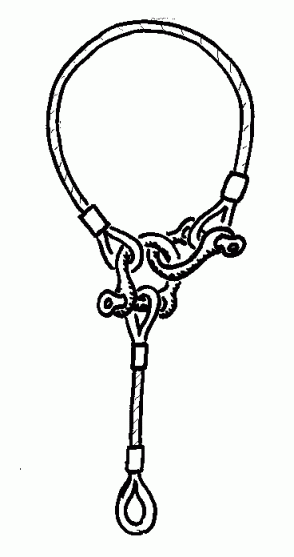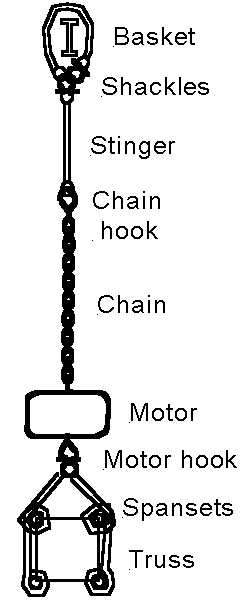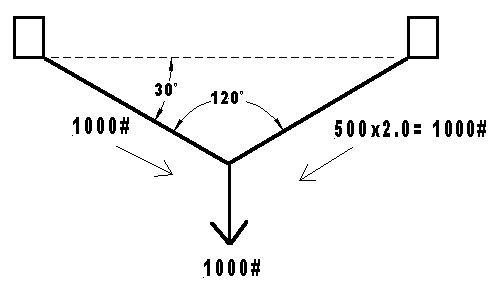In recent years, the use of specialty and temporary rigging for road shows has become commonplace. As recently as 30 years ago, special rigging was the exception, not the rule. Even for arena shows overhead rigging was rare, and used mostly for circuses and ice shows. Today that is all changed. Concerts in arenas may use a score or more specially hung "points", and even small stage shows are likely to "drop" a half-dozen points. Rigging has become integral to many shows, especially road shows.
The people who crawl across the ceiling and drop the points are called riggers. The "up rigger" is the overhead person who secures the rigging equipment in place. Often he hauls it up on a rope by main strength. The "down rigger" is on the floor. He assembles the gear, ties it to the up rigger's rope, feeds out the motor chain, and often hauls it up by pulling on the rope dropped by the up-rigger through a pulley.
The primary job of riggers on most shows is to hang chain motors to suspend trusses and other heavy points. To do so, they used some standardized equipment.
Chain motor: the standard motor is a one-ton industrial chain motor. These were originally designed to be hung from the ceiling chain-down, but they have be re-configured to work inverted (motor down) specifically for theatre, mostly by inverting the contactor that turns it on. Theatre motors are painted BLACK; standard motors are orange. They are NOT interchangeable.
Chain motors have two leads, a power cable and a control cable. The connectors are usually twist-lock so as not to be confused with other cables. Control is electrical, not "electronic", so control wire must be "high" voltage type, not "low voltage". Traditionally this is one of the few places in theatre that type SJ cable is acceptable. Most chain motors are 3-phase. If they run backwards, it can be corrected by reversing any two of the three hot wires.
A standard motor chain is 85 ft. long.

"Steel": name given to heavy steel rope, or a heavy aircraft cable. This is usually 1/2" cable with loops made with thimbles and swage fittings at each end. They come in standard lengths of: 5 ft., 10 ft., 20 ft., 30 ft., 50 ft., and have a Safe Working Load of about 4500 lb.
Shackles: usually anchor shackles with screw in pins fitted to 1/2" cable. Used to connect most parts together. They should NEVER be tightened more than finger-tight.
Basket: to form a closed loop around something, such as an overhead support beam , by connecting both ends of a length of steel to a shackle so that the loop does not tighten on the object.
Choker: to form a loop around something that slides tight and grabs under load, basically forming a larks head or "tie-line knot" around the object. Commonly used to attach a spanset to a truss.
Stinger: A length of steel cable used to extend the motor chain to it can reach to the overhead suspension point.
Span-sets: trade name for polyester round-sling. This is a loop of polyester tube enclosing a long bundle of continuous polyester filaments. They are wrapped around the truss load, and they are able to provide a soft, strong support that can lift a truss without crushing the aluminum tubing.
Dead hang: to suspend a load directly below an attachment point.
Bridle: to suspend a chain motor and its stinger form two points so that it falls somewhere between them.
Rigging rope: This is usually a 5/8" or 1/2" polyester or polypropylene rope with a good hand, long enough to reach to the floor with some length left over. A rope almost twice as long as the ceiling height and a pulley will allow the down-rigger to assist the up-rigger in hauling up the load.
"Wheel": A split-side rescue pulley borrowed from rock climbing, often used by a rigger to help haul up a load. Used with a webbing loop and a carabiner to attach to an overhead structure. The split-side allows the pulley to be placed onto the middle of the rope.
Carabiner: a large snap-link with a spring-loaded gate, which usually also has a way to lock the gate closed. Steel 'beaners are much preferred over aluminum 'beaners, which can fail unexpectedly.
"Pickle": a small controller with an Up contact and a Down contact, usually on a rocker switch, which can operate one motor at a time.
A common load on chain motors is a truss. Working from floor to ceiling, the equipment used would typically be as follows:

The very FIRST thing must be to make sure the overhead building structure will actually support the loads to be hung. That MAY take input from a licensed structural engineer. You can't tell just from looking. Assuming that the ceiling is strong enough:
The "show rigger" will first measure and mark the floor where the point is to go. This is usually done with a large soft chalk so the rigger can see it from the ceiling. The show rigger will determine just how a point will be hung, whether the point can be "dead hung" or "bridled". He will decide if the motor chain will go all the way to the ceiling or if a "stinger" will be added. The chain is 85 ft. long, but a foot of steel weighs less than a foot of steel chain, and a stinger may be added to make the chain longer or make it easier to haul up. He will then give the directions to the down rigger.
The down-rigger will collect the necessary equipment from the "rigging steel" crate. The down-rigger will collect whatever combination is needed and lay it out at each point for assembly.
The down-rigger will assemble the point hardware according to instructions. For instance, A "five- basket with a 20- stinger" will have a five foot cable to form a basket around the suspension beam, attached to a 20 ft. cable which attaches to the end hook of the motor chain. A "5- 10- bridle with 5- baskets and a 15- stinger" will form a bridle with a 5 ft. leg and a ten ft.leg, each with a 5 ft. basket at the top, and both attached with one shackle to a 15 ft. stinger. The stinger will probably be a 10 ft. cable and a 5 ft. cable shackled together, the end of which will be attached to the motor chain.
The up-rigger will move into position over the point mark on the floor and let down a rigging rope. Often he will first set a web strap and wheel overhead and pass the rope through it to make hauling on the rope easier.
The down-rigger ties the "steel" assembly on to the rope with a Bowline. He will usually also put a burlap bag through the loop of the bowline. The basket may be open or closed as needed. For an open basket the basket cable is NOT attached to the extra shackle, and the rope is tied to the connecting shackle immediately beside the thumb tab of the shackle pin. The extra shackle should be opposite the bowline. For a closed basket the "other" end of the basket is connected to the extra shackle to form a closed loop, in which case the rigging rope is tied to the top of the basket loop.
The down-rigger should ask his up-rigger how large the loop in the bowline should be, and must be careful to tie it in the right place correctly, or the up-riggers job will be difficult to impossible.
The up-rigger hauls up the point, sometimes with the help of the down-rigger, and secures it to the suspension point on ceiling.Once the up-rigger calls down to "take weight", the down-rigger tugs on the chain to settle it on the support, then connects power to the motor and runs it up off the ground with the pickle.
To fly a truss, two span-sets will be choked to either side of the truss on the bottom pipes, wrapped around the upper pipes in passing, then both are be fastened together to a shackle, which is attached to the chain motor's hook. A chain bag is attached to the motor, and then the excess chain is fed into the bag and arranged so that it will continue feeding into the bag as the motor is flown.
With a bridle, the total load on the motor is divided between legs of the bridle, but calculating the loads placed on the actual hanging points are not that simple. There is a sideways pressure applied to the points as the legs pull against each other as well as against the load, so you also have to multiply the load by a factor corresponding to the angle of the leg below horizontal to determine the equivalent loading on that leg.
Based on the Backstage Handbook, by Paul Carter, for angles measured relative to horizontal, the factors for equal length bridles are (approx):
| Angle to Horiz | Between legs | Mult. factor | Angle to Horiz | Between legs | Mult. factor | |
|---|---|---|---|---|---|---|
| 10° | 160° | 5.76 | 55° | 70° | 1.22 | |
| 15° | 150° | 3.86 | 60° | 60° | 1.15 | |
| 20° | 140° | 2.92 | 65° | 50° | 1.10 | |
| 25° | 130° | 2.37 | 70° | 40° | 1.064 | |
| 30° | 120° | 2.00 | 75° | 30° | 1.035 | |
| 35° | 110° | 1.74 | 80° | 20° | 1.015 | 40° | 100° | 1.56 | 85° | 10° | 1.004 |
| 45° | 90° | 1.41 | 90° | 0° | 1.00 | |
| 50° | 80° | 1.31 |
(For the trigonomically inclined, these multipliers are actually the cosecants of the angles. A cosecant is the ratio of the hypotenus / opposite side from the angle, or the length of the bridle leg / the vertical rise.)

For example: assume a 1000 lb. load hanging on two equal length bridles at 30° below horizontal (120° between legs). Equal length bridles are fairly simple; the load divides equally between the legs, so vertical loading for each leg will be 500 lb. However, the effective tension load on each leg of the bridle will be greater than its vertical load by the multiplier factor. For a 30 ° angle the multiplier is 2: (The saying is "Thirty degrees, double the load.") So, if we have a 1000 lb. load, when divided between them will give 500 lb. vertical load on each leg. Because the legs are at 30°, each load is multiplied by the factor 2, and will be 1000 lb. in tension on each leg!
Basically, the more vertical the leg, the better!
As a rule, do not make a bridle with an angle to horizontal of less than 30°, (i.e. greater than 120° between legs). The forces involved become tremendous very quickly! In an absolutely flat bridle, the load is theoretically infinite.
When the legs are unequal in length and the angles are different, the problem becomes much more complex. The load will be divided unequally between the legs, and the calculations must factor in both legs simultaneously. Fortunately, the show rigger is usually responsible for calculating the resulting loads, but the Local's riggers need enough background in the principles to recognize and question loads and loading that appear suspect in our venues.